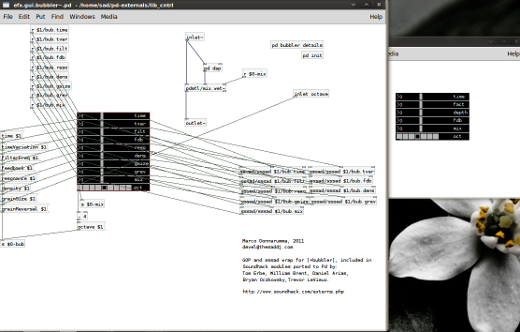
Its also going to support midi learn too, so you can use it with ‘dumb midi controllers’… basically setup on something with a display, then simply copy the preset file over to use on a completely headless device. for the PiSound, I plan to do a small Juce app, that will allow me to control these things the 7" touchscreen ive got attached to my rPI.Īs the parameters are all distributed via OSC, I could also push the UI to an iPad, e.g. Ultimately this is a distribute parameter system, so I can also render it to other controllers… e.g.
#Soundhack pd externals into pd vanilla mac#
the above works on macOs/Linux/rPI/Bela - I use the mac for developing patches then use them elsewhere) Sure this might mean some ‘patch adaptation’, but the idea is simple… do it once, then use it everywhere The reason for this is pretty simple… why would you want to render 6 lines of display, and four pots, if you have a higher resolution display with a touch screen? (or encoders and hi res push display in this instance) (in this demo the Push 2 with an Organelle, but runs fine with Push 2 on the rPI)
#Soundhack pd externals into pd vanilla Patch#
I can write organelle patches with it, and they will display correctly on the organelle BUT the same patch can also be used on any other PD platform, with other controllers. Im creating a parameter system that is portable, i.e. (which I could easily do, by just interpreting the organelle ‘mother osc’ messages) Im taking a different approach, rather than aiming at being 100% compatible with the Organelle But maybe somebody has insight about this? Most likely, there wouldn’t be anything specific to the HAT, especially if some of the available GPIO ports are enough to make things work. Wonder how difficult it’d be to reproduce the same functionality with pisound (the DIY project uses the stm32f0 board to interface with the actuators and sensors). So, there probably isn’t any incompatibility with the board itself. There’s at least one person who’s built a Raspberry Pi setup which works directly with those Organelle patches. It uses a small LCD screen, a few knobs, and a “keyboard” with little buttons. Like pisound, Organelle is meant to be used headless. Also, there are some Automatonism modules to support the Organelle. The Organelle site has a good number of example patches which cover some pretty neat use cases.

Part of the thinking which got me to back this campaign is the dream of a DIY version of the Critter & Guitari Organelle (a Pd-based hardware device which works as an instrument or FX box, etc.).


 0 kommentar(er)
0 kommentar(er)
